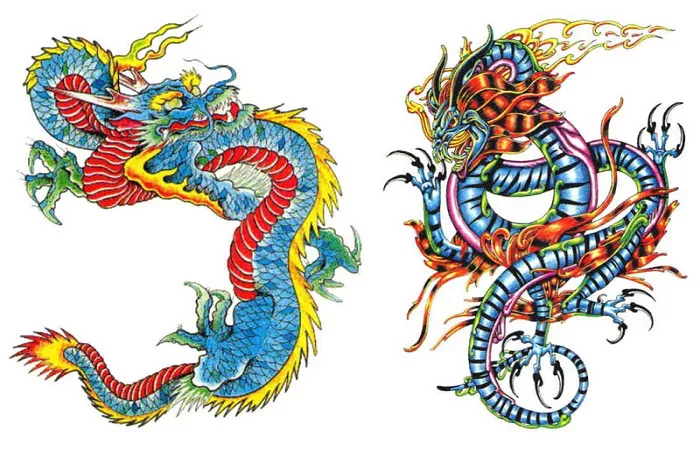Dragons have been a popular tattoo design for centuries, with many cultures and traditions incorporating these mythical creatures into their art and mythology. Two of the most popular dragon tattoo designs are the Chinese dragon and the Japanese dragon. While both designs share similarities, there are also distinct differences between them. In this article, we will explore the differences between Chinese dragon and Japanese dragon tattoos, including their history, symbolism, and design elements.
The History of Chinese Dragon Tattoos
Chinese dragon tattoos have a long and rich history in Chinese culture. Dragons are considered to be powerful and benevolent creatures, symbolizing strength, wisdom, and good fortune. In Chinese mythology, dragons are associated with the emperor, and are often depicted in art and literature as guardians of the heavens and protectors of the people.
Chinese dragon tattoos often feature a long, serpentine body with four legs and sharp claws. They are typically depicted in bright colors, such as red and gold, and may include other elements such as clouds, flames, or pearls. The design of the Chinese dragon tattoo is heavily influenced by the traditional Chinese art style, which emphasizes bold lines and bright colors.
The History of Japanese Dragon Tattoos
Japanese dragon tattoos also have a long history, dating back to the Edo period in Japan. In Japanese mythology, dragons are associated with water and are often depicted as powerful and fearsome creatures. They are also associated with the emperor, and are believed to bring good luck and fortune.
Japanese dragon tattoos often feature a more stylized design, with a long, slender body and clawless feet. They are typically depicted in black and gray, and may include other elements such as waves, clouds, or cherry blossoms. The design of the Japanese dragon tattoo is heavily influenced by the traditional Japanese art style, which emphasizes delicate lines and subtle shading.
Symbolism of Chinese Dragon Tattoos
Chinese dragon tattoos are rich in symbolism, representing power, strength, and good fortune. They are also associated with the emperor and are believed to bring protection and prosperity. In Chinese culture, the dragon is a symbol of the yang energy, representing masculinity, vigor, and fertility.
Chinese dragon tattoos often feature intricate designs, with detailed scales and sharp claws. They may also include other elements such as flames or pearls, which further enhance their symbolism. The colors used in Chinese dragon tattoos also have significant meaning, with red symbolizing good fortune and gold symbolizing wealth and prosperity.
Symbolism of Japanese Dragon Tattoos
Japanese dragon tattoos also have significant symbolism, representing power, strength, and wisdom. They are believed to bring good luck and fortune, and are often associated with water and the sea. In Japanese culture, the dragon is a symbol of the yin energy, representing femininity, grace, and beauty.
Japanese dragon tattoos often feature a more stylized design, with a long, sinuous body and delicate features. They may also include other elements such as waves or cherry blossoms, which further enhance their symbolism. The black and gray color scheme used in Japanese dragon tattoos is meant to create a more subtle and understated effect, emphasizing the delicate lines and shading of the design.
Design Elements of Chinese Dragon Tattoos
Chinese dragon tattoos often feature intricate design elements, with detailed scales, sharp claws, and a long, serpentine body. They may also include other elements such as flames, clouds, or pearls, which add to their symbolism and visual appeal. Chinese dragon tattoos are typically depicted in bright colors, such as red and gold, which further enhance their dramatic effect.
The design of the Chinese dragon tattoo is heavily influenced by the traditional Chinese art style, which emphasizes bold lines, vibrant colors, and intricate details. The dragon in Chinese culture is often depicted as a powerful and benevolent creature, symbolizing strength, wisdom, and good fortune.
Design Elements of Japanese Dragon Tattoos
Japanese dragon tattoos also feature intricate design elements, with a long, slender body and delicate features. They may include other elements such as waves, clouds, or cherry blossoms, which add to their symbolism and visual appeal. Japanese dragon tattoos are typically depicted in black and gray, which gives them a more subtle and understated effect.
The design of the Japanese dragon tattoo is heavily influenced by the traditional Japanese art style, which emphasizes delicate lines, subtle shading, and negative space. The dragon in Japanese culture is often depicted as a powerful and fearsome creature, symbolizing strength, wisdom, and good luck.
Choosing Between Chinese Dragon and Japanese Dragon Tattoos
When choosing between Chinese dragon and Japanese dragon tattoos, it is important to consider your personal preferences and the symbolism behind each design. Chinese dragon tattoos are typically more dramatic and colorful, while Japanese dragon tattoos are more subtle and understated. Both designs have significant symbolism and can be a powerful and meaningful way to express your beliefs and values.
It is also important to consider the size and placement of the tattoo, as well as the skill and experience of the tattoo artist. A skilled tattoo artist can help bring your vision to life and create a design that is both visually stunning and meaningful.
Conclusion:
Chinese dragon and Japanese dragon tattoos are both popular and meaningful tattoo designs, each with their own unique history, symbolism, and design elements. By understanding the differences between these two designs, you can choose the one that best reflects your personal style and beliefs. Whether you choose a colorful and dramatic Chinese dragon tattoo or a subtle and understated Japanese dragon tattoo, your tattoo is sure to be a powerful and meaningful expression of your individuality.
Related topics:

